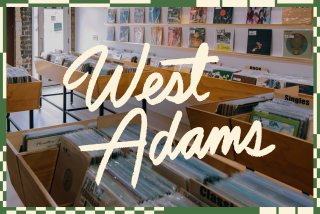Celebration of a Neighborhood’s Work of Art
- Share via
For three decades, the small artist’s colony of St. Elmo Village has been tucked away in a Mid City area of Los Angeles struggling to define itself in the midst of economic upheaval, ethnic transition and a high crime rate.
It’s the kind of neighborhood that people have grown accustomed to fleeing as soon as times got better. But for the dozen or so artists in St. Elmo Village, the instability has provided an ideal scenic backdrop.
“This community was always a stopover, a place to rest on the way to something better,” said Roderick Sykes, 53, the village’s co-founder. “Our goal has always been to help people see the beauty that’s around them, to see what’s in their own backyard.”
As Sykes spoke, he motioned to the drummers and dancers of a local Aztec dance troupe performing Saturday before scores of onlookers attending the first of a two-day celebration marking St. Elmo’s 30th anniversary and the unveiling of the village’s $620,000 renovation.
St. Elmo Village, which rests on a half-acre lot, comprises 10 bungalows built as a residential court in the 1920s and a six-unit apartment building purchased in 1994.
In addition to being home to local artists, the village provides art classes for neighborhood adults and children in a quiet setting in the 4800 block of St. Elmo Drive.
Since its birth in the late-1960s, St. Elmo Village has operated with limited funding, relying heavily on volunteers who have helped stage free art workshops and staff the office.
Rozzell Sykes, the late founder of St. Elmo Village, was the first to move into the collection of bungalows, sheds and garages in the decaying neighborhood. Soon, a nephew, Roderick Sykes, joined his uncle in what Rozzell Sykes envisioned as a kind of mission to help people find success within themselves.
By 1971, the Sykeses were able to raise $10,000 from a Memorial Day festival for a down payment on the property that the landlord was going to convert into an apartment complex. Within 10 years, they had transferred the village into an oasis.
This year’s festival returns after a nine-year hiatus as the village struggled to revive some of its heyday during the mid-1970s, when it became a tourist attraction and was featured in national guidebooks.
From jazz to reggae, Aztec to barrio folklorico, the festival was designed to showcase the area’s rich ethnic mix. The festival will continue today beginning at noon with poetry, dance, live music and drumming.
Opening the festival Saturday, Abdul Salaam Muhammed poured a small libation in the African tradition, announcing to the largely African American and Latino gathering that there were common ties that brought them together.
“No one on earth can tell us that we are not of one humane soul,” he said.
Then echoing the same theme, Oscar Cisneros spoke for Danza Azteca and greeted the crowd.
“This land is indigenous land,” he said. “Welcome home.”
Once the festivities began, the children crowded around different art events, drawing and displaying their ceramics.
“It’s great,” said Annabel Contreras, 11. “I like to paint houses. One day I want to live in a house.”
At 14, Xitlali Amador said she loved creating ceramic art, but she saw other benefits.
“Art keeps you off the streets and out of trouble,” she said.
“It’s a positive outlet for the children, and parents need places like this to bring their children,” said Lynne Conner-Smith, who as a child attended art classes at St. Elmo Village and brought her children Saturday to share in the experience.
Rodney Sharpp, now 40, said he was 9 when he first visited the village.
“This is one of the places we came, and no matter who we were, we felt special,” said Sharpp.
More to Read
The biggest entertainment stories
Get our big stories about Hollywood, film, television, music, arts, culture and more right in your inbox as soon as they publish.
You may occasionally receive promotional content from the Los Angeles Times.










